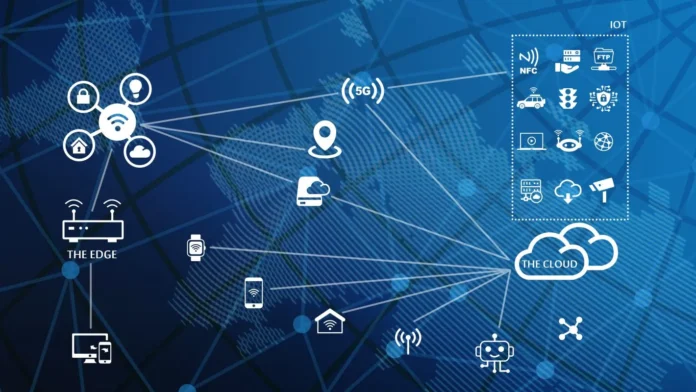
Cloud computing refers to the delivery of computing services — including servers, storage, databases, networking, software, and more — over the internet, providing users with access to flexible and scalable resources without the need for on-premises infrastructure.
This paradigm shift in IT infrastructure has enabled organizations to streamline operations, innovate rapidly, and scale their resources according to demand.
Evolution and Historical Perspective
The concept of cloud computing traces back to the 1960s, with the development of utility computing and time-sharing systems.
However, it wasn’t until the early 2000s that cloud computing began to gain traction, thanks to advancements in virtualization, broadband internet, and the emergence of internet giants like Amazon, Google, and Microsoft.
How Cloud Technology Works?
At its core, it relies on a network of remote servers hosted on the internet to store, manage, and process data, rather than a local server or personal computer. This distributed model allows users to access resources and services on-demand from anywhere with an internet connection.
Types of Cloud Computing Services
There are several types depending on the purpose:
- Infrastructure as a Service (IaaS) ─ IaaS provides virtualized computing resources over the internet, including virtual machines, storage, and networking, allowing users to deploy and manage their own applications and services without the need for physical hardware.
- Platform as a Service (PaaS) ─ PaaS offers a complete development and deployment environment in the cloud, providing developers with tools, frameworks, and middleware to build, test, and deploy applications more efficiently.
- Software as a Service (SaaS) ─ SaaS delivers software on the cloud over the internet on a subscription basis, eliminating the need for users to install, maintain, and update software locally. Popular examples include Google Workspace, Microsoft 365, and Salesforce.
- Function as a Service (FaaS) ─ FaaS, also known as serverless computing, enables developers to run individual functions or pieces of code in response to events, without managing the underlying infrastructure. This pay-per-use model is ideal for event-driven and microservices architectures.
Characteristics and Benefits

This technology offers several key advantages:
- Scalability ─ Resources can be scaled up or down dynamically to accommodate fluctuations in demand, ensuring optimal performance and cost-efficiency.
- Flexibility ─ Users can access services from any device with an internet connection, enabling remote work and collaboration.
- Cost-efficiency ─ It eliminates the need for upfront investments in hardware and infrastructure, allowing organizations to pay only for the resources they use.
- Business continuity ─ Cloud-based backups and disaster recovery solutions ensure data resilience and minimize downtime in the event of a disaster.
- Environmental benefits ─ By consolidating resources and optimizing energy consumption, reduces the carbon footprint of IT operations.
Challenges and Considerations
Despite its many benefits, cloud computing also presents challenges:
- Security concerns ─ Storing sensitive data off-premises raises concerns about data breaches, unauthorized access, and compliance with data protection regulations.
- Management and governance ─ Managing multiple cloud environments and ensuring compliance with organizational policies require robust governance frameworks and monitoring tools.
- Compliance and regulatory challenges ─ Different regions have varying data protection laws and regulations, complicating compliance efforts for multinational organizations.
Cloud Computing vs. Traditional Web Hosting

Compared to traditional web hosting methods, cloud solutions offers several advantages, including:
- Scalability ─ Resources can be scaled more easily to accommodate growing traffic and workloads.
- Flexibility ─ Platforms offer a wider range of services and deployment options, catering to diverse application requirements.
- Cost-efficiency ─ Pay-as-you-go pricing models and resource optimization tools help minimize costs and maximize ROI.
- Reliability ─ Cloud providers offer robust infrastructure and service level agreements (SLAs) to ensure high availability and uptime.
Hybrid and Multi-Cloud Strategies
Hybrid and multi-cloud strategies represent a transformative approach in cloud computing, blending the strengths of both private and public clouds, as well as leveraging multiple cloud providers to meet specific operational needs.
These strategies offer unparalleled flexibility, enabling organizations to balance cost, performance, and regulatory compliance more effectively.
A hybrid cloud setup allows for sensitive data to remain within a secure, private cloud, while scalable, cost-effective public cloud resources can be used for less sensitive operations.
Multi-cloud environments, on the other hand, prevent vendor lock-in and optimize resources by choosing best-in-class services from various providers, thereby enhancing business resilience and agility.
Integration of Edge Computing

The integration of edge computing with cloud technologies marks a significant evolution in data processing, particularly beneficial for IoT and real-time applications. By processing data closer to its source, edge computing significantly reduces latency and conserves bandwidth, thereby enhancing the efficiency of cloud services.
This symbiosis supports a new generation of applications, from autonomous vehicles to smart cities, where immediate data analysis is crucial. Moreover, edge computing can alleviate the load on central cloud servers, leading to more scalable and resilient cloud infrastructures.
As the volume of data generated by edge devices continues to grow, their integration with cloud computing will become increasingly important for efficient data management and analysis.
Advanced Cloud Security and Privacy Measures
In the realm of cloud computing, advanced security, and privacy measures are paramount due to the inherent risks of storing and processing data off-premises. Enhanced encryption techniques, both in transit and at rest, ensure data integrity and confidentiality.
The adoption of zero trust models, which verify every request as if it originates from an open network, provides rigorous access control. Additionally, innovations like confidential computing, where data is processed in encrypted enclaves, protect against unauthorized access, even from cloud providers themselves. These advanced measures address growing security concerns, making cloud platforms more robust and trustworthy for businesses handling sensitive information.
Expanding on Serverless Architectures

Serverless architectures represent a paradigm shift in cloud computing, enabling developers to focus on code rather than server management. This model abstracts the server layer, automatically managing the allocation and scaling of resources.
Functions as a Service (FaaS) is a popular example, allowing the execution of code in response to events without a continuous server presence. This model promotes cost efficiency by charging only for the resources consumed during the execution time.
The expansion of serverless architectures into broader use cases, including event-driven applications and microservices, offers developers unprecedented scalability and flexibility, paving the way for more innovative and efficient cloud-based solutions.
Sustainability and Green Computing in the Cloud
The environmental impact of IT operations has brought sustainability and green computing to the forefront of cloud computing discussions.
Cloud providers are increasingly focusing on reducing the carbon footprint of their data centers through energy-efficient technologies and renewable energy sources.
Virtualization maximizes hardware utilization, reducing the number of physical servers required and consequently lowering energy consumption. Additionally, cloud providers are adopting advanced cooling technologies and designing data centers in cooler climates to further enhance energy efficiency.
These efforts not only contribute to environmental sustainability but also offer cost savings and improved public perceptions for both providers and users, aligning technological advancement with ecological responsibility.

Conclusion
In conclusion, cloud computing has revolutionized the way businesses leverage technology, enabling innovation, agility, and cost savings on a global scale. As technology continues to evolve, we can expect cloud solutions to play an increasingly integral role in shaping the future of digital transformation.
With the rise of emerging technologies such as artificial intelligence, machine learning, and the Internet of Things, the demand for cloud-based services and solutions will only continue to grow. By embracing the principles of scalability, flexibility, and innovation, organizations can harness the full potential of this technology to drive success in the digital age.






